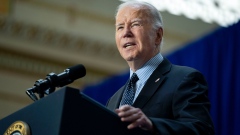May 3, 2023
When will electric vehicle prices drop in Canada?
, BNN Bloomberg
Canada's climate plan is competitive to the U.S.: TD economist
News of electric vehicle pricing cuts and ramped up production efforts have raised hopes that the sticker price could soon be within the budget of the average Canadian driver.
Experts told BNNBloomberg.ca that it may be close to a decade before we see price parity between electric and traditional combustion-engine cars, but the landscape for EVs is changing quickly, with government incentives and increased manufacturing likely to help push down consumer costs.
Rachel Doran, director of policy and strategy at think-tank Clean Energy Canada, said she sees conditions coming together for EV prices to start dropping.
“We see these different factors of public policy, the ramp-up in investments in the battery supply chain, automakers really competing for customers, that are all going to intersect to keep bringing those topline numbers down for the purchase of EVs,” Doran said.
HOW MUCH DOES AN EV COST IN CANADA NOW?
Electric vehicle prices range from $40,000 to $189,000 in Canada, according to data compiled by the Canadian Automobile Association. Most fall between $50,000 and $90,000.
Those price tags don’t include up to $5,000 in federal incentives for electric and hybrid vehicle purchases, or other rebates and savings that vary by province and territory.
MORE COMPETITION
More car manufacturers are jumping into EV production and competing for customers. Doran said that is a good sign that EV sticker prices will start coming down – and some already have.
“Until now, there just really hasn't been that much competition in the market, so I think it's exciting,” she said in a telephone interview.
“That's really going to have an impact on what kinds of EVs will be available to Canadians and the kinds of price points they'll be available at.”
Robert Karwel, senior manager, power information network Canada at J.D. Power & Associates, said he anticipates vehicle prices will drop slightly overall this year, but he sees the EV pricing situation as complicated.
The price gap between EVs and combustion engine cars has only ever increased in Canada, he said, and while prices are dropping for luxury EV models, the opposite is true in the mainstream vehicle market. That’s because manufacturers are coming out with new models, but those cars are more expensive than the compact hatchbacks like the Nissan Leaf that was one of the first on the market for average consumers.
'PRICE WAR?'
Price cuts by Tesla earlier this year, followed by similar moves by other manufacturers, have sparked media speculation about an EV “price war.” Tesla raised its prices on some models this week, but a recent report from Reuters said the company is preparing to sell a cheaper, Chinese-made version of its Model Y in Canada sometime this year.
Karwel noted that Tesla price cuts so far haven’t done much to affect the overall price gap between electric cars and combustion engines because they were already so much more expensive to begin with, but he still expects EV prices to start coming own as manufacturers scale up production and enter the market.
“There's going to be some pricing relief of these vehicles in general, but it's still going to take a while before we see that,” he said.
He noted, however, that some car companies already have price gaps lower than $10,000 between their electric and equivalent traditional models, before factoring in the government rebates that could bring costs even lower.
ECONOMIC CONDITIONS AND PUBLIC POLICY
Federal incentives like rebates and sales targets play a role in helping drive down prices, Doran said, because they essentially force manufacturers’ hands to start selling more affordable options.
The federal government offers between $2,500 and $5,000 for the purchase of an electric vehicle, and provinces have other offerings that can be stacked onto that.
Canada has also set a goal for sales targets that would require 20 per cent of new vehicles sold in Canada to be zero emissions by 2026, increasing incrementally up to 100 per cent by 2035.
Policies in the United States, such as the green tech-friendly Inflation Reduction Act and new proposed tailpipe regulations for vehicles, can also serve to help push down prices in economically linked Canada, Doran said.
Other economic conditions play a role in customers’ decisions about their car purchases, Karwel noted. For example, high interest rates could mean hefty extra costs on an already expensive EV purchase.
PRICE PARITY
Both experts agreed that the timeline to price parity between combustion and electric vehicles is unclear.
Karwel said he doesn’t see it happening before the next decade, and he considers price parity as a “moving target,” as many manufacturers are still making profits from gas-powered vehicles.
Doran said despite the market complexities, she would be “very surprised if it took a decade for Canada to start seeing automakers be able to really put some things in the market in the window that are very cost competitive to traditional (internal combustion engine) vehicles.”
In the meantime, Clean Energy Canada and other EV proponents have made the case that despite a higher sticker cost, electric cars generally save drivers money over time on costs such as gas and maintenance.









